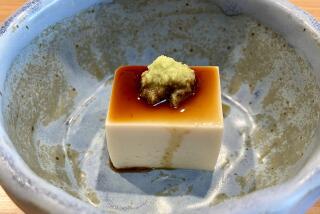The Real Skinny : Selling Diet Food to Japanese Weighs In as a Bad Idea
- Share via
TOKYO — In the grand tradition of selling iceboxes to Eskimos, companies here are now doing their low-calorie best to sell diet foods to the Japanese.
In the United States, of course, weight-conscious Americans have turned the diet food and drink market into a more than $30-billion industry. A “fat-free” or “lo-cal” label often can make a product rocket from the shelves.
Now, Japan’s leading food companies--such as giant Snow Brand Milk Products and Q. P. Corp., the country’s largest mayonnaise and salad dressing producer--want to emulate this triumph of American marketing. There’s now “Q. P. Half” mayonnaise and Snow Brand’s new “Butter Half” low-fat butter. Selling low-fat and low-calorie food has taken on an urgency here that would bring a smile to any American nutritionist.
However, Japan is still a long way from having a yen to import Richard Simmons. Even with the popularity of McDonald’s Big Makku, this remains a country of tofu, sushi and rice. As of 1989, the average Japanese gobbled up about 2,061 calories a day; that compares to 3,500 calories daily for the typically indulgent American. What’s more, Japan’s per-person fat intake averages a skinny 59 grams a day; the U.S. average is 169 grams.
So why is there this consumer demand for low-calorie, fat-free food products? The answer is, there isn’t. Hiro Takeuchi, a professor at Hitotsubashi University, says: “The word diet still conjures up images of obese people who need to lose pounds of meat. Just look around . . . there are very few obese people here.”
What has happened is innovation for the sake of innovation. Japanese companies, hungry for market share and more shelf space, commonly trot out new products with marginal improvements, hoping to stimulate consumer demand. Sony does it with Walkmans; Matsushita does it with VCRs.
Diet foods represented a market segment that (understandably) had virtually no competition. So Japan’s food companies hope to use diet products to create a consumer market rather than to serve one. While there’s method to their madness, it’s still madness.
You might recall how Coca-Cola flopped here in 1984 when it tried to introduce its best-selling American Diet Coke as Coke Light. (Coca-Cola was at least clever enough not to use the diet label.)
Takeuchi, who worked with Coke, says the company realized that it had to sweeten the formula and thus add a lot more calories. Re-released three years ago, sales of newly sweetened Coke Light have grown 20% a year, making it the first “low-calorie” drink to succeed in Japan.
To be sure, diet products that also taste good do well in Japan. Q. P. Half mayonnaise is now the best-selling dressing in the Seiyu supermarket chain precisely because it lives up to its motto: “The same taste, for half the calories.”
However, even if they taste good, low-calorie foods face customer resistance because they cost more. You have the unusual market spectacle of a skinny nation being charged a premium for diet foods.
Daisuke Kawashima, who runs the food section at the tony Mitsukoshi Department Store in the Ginza district, is skeptical whether consumers will continue to pay a premium for diet foods. He says the Japanese are very interested in healthier eating, such as organically grown foods, but “low calorie is not so important to us.”
The big food rage in this country are products with added calcium, following a 1991 Japanese government report that listed calcium as the one element lacking in the Japanese diet.
Mitsuru Miyata, editor of Nikko Biotechnology, says the future of food marketing in Japan won’t be in low-fat, low-calorie foods but instead it will be in “functional foods” that offer specific health benefits.
“Reduction of fat is a simple issue,” Miyata says. “With biotechnology, we will create food that not only reduces fat but strengthens teeth and promotes the health of our internal microorganisms that aid our digestion.”
Miyata points to a dozen Japanese companies--including Snow Brand--that are exploring how to improve foods through biotechnology. That research is not primarily focusing on artificial sweeteners and fat substitutes, as in the West, he adds.
In other words, rather than mimic the West’s obsession with thin thighs, Japanese food companies will be using biotechnological innovations to capture market share. While it may be possible to sell iceboxes to Eskimos, it’s not likely to be the sort of growth market that can keep a business prosperous, even in Japan.
More to Read
Inside the business of entertainment
The Wide Shot brings you news, analysis and insights on everything from streaming wars to production — and what it all means for the future.
You may occasionally receive promotional content from the Los Angeles Times.










